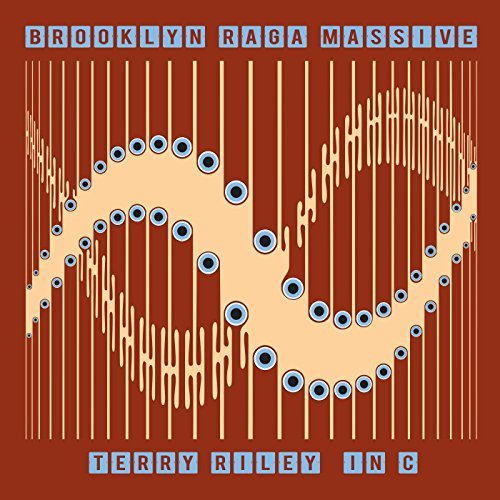
Brooklyn Raga Massive - Terry Riley In C (2017)
BAND/ARTIST: Brooklyn Raga Massive
- Title: Terry Riley In C
- Year Of Release: 2017
- Label: Northern Spy Records
- Genre: Classical, World
- Quality: FLAC (tracks+.cue+.log)
- Total Time: 1:14:53
- Total Size: 445 MB
- WebSite: Album Preview
Brooklyn Raga Massive is a collective of musicians rooted in Indian classical music. That tradition rarely involves an ensemble larger than three or four players. Sitarist Neel Murgai identified Terry Riley's canonical minimalist composition In C—an open scored collection 53 short musical phrases that the players repeat and move through at their own pace—as an accessible way for a large number of Indian musicians to play together. This album is a live concert recording with 18 players. The instrumentation is sitar, sarod, bansuri, vocals, tabla, hammered dulcimer, oud, violin, cello, upright bass, dragon mouth trumpet, guitar, cajon, riq and frame drum.
In C has been arranged for various groupings over the years, and this is not the first employing non-Western instruments. Montreal's Ensemble de la SMCQ's 1997 performance (Atma Classique, 2000) included sitar and tabla (along with Western instruments and chorus), and featured a raga-style free introduction. Before that, the Shanghai Film Orchestra performed it entirely on traditional Chinese instruments (Celestrial Harmonies, 1989). After hearing an early performance recording, Terry Riley suggested that the Brooklyn Raga Massive use the basic form of the composition, but open it up to solos based on the patterns. So this performance fully embraces both Indian instruments and Indian classical music performance tradition.
The performance begins with "Raga Bihag Alap," the improvised, unmetered introduction that introduces the raga in a traditional performance. As the piece proper is begun, the part of the Pulse (the metronomic beat usually played on a piano) is introduced by tabla. Then the group begins moving through the patterns, which are banded in groups on the recording ("Cells 1-8" through "Cells 49-53 (Jhalla)"). In one way the piece sounds very familiar, especially the sound of the opening phrases, despite the unexpected sound of the Indian instruments. When there is audible improvisation—e.g. the bansuri solo in "Cells 12-13"—it grows out of the patterns so naturally that it sounds like it had been hidden in the composition all along, waiting to be revealed. The fast jhalla that concludes the performance is another traditional raga performance gesture, which again sounds completely natural in context.
Terry Riley is a longtime practitioner of Indian classical vocal music, having studied with Pandit Pran Nath. It seems appropriate that this performance should bring his early composition fully into that world, and it's a fresh view of a piece that was already full of possibilities.
Tracklist:
01. Brooklyn Raga Massive - Raga Bihag Alap
02. Brooklyn Raga Massive - Cells 1-8
03. Brooklyn Raga Massive - Cells 9-11
04. Brooklyn Raga Massive - Cells 12-13
05. Brooklyn Raga Massive - Cells 14-16
06. Brooklyn Raga Massive - Cells 17-21
07. Brooklyn Raga Massive - Cells 22-27
08. Brooklyn Raga Massive - Cells 28-34
09. Brooklyn Raga Massive - Cells 35-41
10. Brooklyn Raga Massive - Cells 42-47
11. Brooklyn Raga Massive - Cell 48
12. Brooklyn Raga Massive - Cells 49-53 (Jhalla)
In C has been arranged for various groupings over the years, and this is not the first employing non-Western instruments. Montreal's Ensemble de la SMCQ's 1997 performance (Atma Classique, 2000) included sitar and tabla (along with Western instruments and chorus), and featured a raga-style free introduction. Before that, the Shanghai Film Orchestra performed it entirely on traditional Chinese instruments (Celestrial Harmonies, 1989). After hearing an early performance recording, Terry Riley suggested that the Brooklyn Raga Massive use the basic form of the composition, but open it up to solos based on the patterns. So this performance fully embraces both Indian instruments and Indian classical music performance tradition.
The performance begins with "Raga Bihag Alap," the improvised, unmetered introduction that introduces the raga in a traditional performance. As the piece proper is begun, the part of the Pulse (the metronomic beat usually played on a piano) is introduced by tabla. Then the group begins moving through the patterns, which are banded in groups on the recording ("Cells 1-8" through "Cells 49-53 (Jhalla)"). In one way the piece sounds very familiar, especially the sound of the opening phrases, despite the unexpected sound of the Indian instruments. When there is audible improvisation—e.g. the bansuri solo in "Cells 12-13"—it grows out of the patterns so naturally that it sounds like it had been hidden in the composition all along, waiting to be revealed. The fast jhalla that concludes the performance is another traditional raga performance gesture, which again sounds completely natural in context.
Terry Riley is a longtime practitioner of Indian classical vocal music, having studied with Pandit Pran Nath. It seems appropriate that this performance should bring his early composition fully into that world, and it's a fresh view of a piece that was already full of possibilities.
Tracklist:
01. Brooklyn Raga Massive - Raga Bihag Alap
02. Brooklyn Raga Massive - Cells 1-8
03. Brooklyn Raga Massive - Cells 9-11
04. Brooklyn Raga Massive - Cells 12-13
05. Brooklyn Raga Massive - Cells 14-16
06. Brooklyn Raga Massive - Cells 17-21
07. Brooklyn Raga Massive - Cells 22-27
08. Brooklyn Raga Massive - Cells 28-34
09. Brooklyn Raga Massive - Cells 35-41
10. Brooklyn Raga Massive - Cells 42-47
11. Brooklyn Raga Massive - Cell 48
12. Brooklyn Raga Massive - Cells 49-53 (Jhalla)
Year 2017 | Classical | World | Indian / भारतीय संगीत | FLAC / APE
As a ISRA.CLOUD's PREMIUM member you will have the following benefits:
- Unlimited high speed downloads
- Download directly without waiting time
- Unlimited parallel downloads
- Support for download accelerators
- No advertising
- Resume broken downloads


